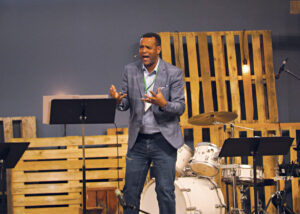Why do people switch or exit a church or denomination? And why do some churches leave a denomination altogether?
Chances are you could offer possible reasons from your own experiences or those around you. Anecdotes are helpful to a point, but larger data sets based on extensive surveys or interviews across different populations can offer richer and typically more accurate explanations.
I offer my work as a sociologist of religion in an effort to shed light on prevailing research findings on “switchers” and “exiters.” Switchers are those who transition from one congregation or denomination to another—what Reginald Bibby famously called “the circulation of the saints”—while exiters include those who stop attending altogether.
When I say I hope to shed light, my aim is to provide a description of what is, rather than dictate what ought to be. At the same time, I hope this description will be thought-provoking for those in the church considering what ought to be done about these phenomena.
There are several push-and-pull factors associated with switching or exiting congregations. Prior research—including two of my own books, The Meaning of Sunday and None of the Above—highlights several of these variables. In no particular order, these factors include: conflict with a leader or congregant; preaching style and/or content; leadership change; financial or sexual scandal; hospitable and welcoming atmosphere; close social ties with others in the group; church size (too large or too small); programming (e.g., age, gender, or special interest-based); music style; theological beliefs regarding salvation, leadership or gender and sexuality; political views; life transition (e.g., relocation, divorce, death of a loved one); busyness; or social position within a congregation.
Sometimes the absence of certain features in one congregation or denomination becomes a push factor, while simultaneously serving as a pull factor if present elsewhere.
Biographical context also matters. For example, switching typically occurs between similar denominations (e.g., a Mennonite may more easily become a Baptist than a Catholic). Stage of life— such as being single, having young children, or recently retiring—also shapes how people weigh different church options.
It is important to stress that no single variable uniformly captures congregational switching or exiting. Even for a particular switcher or exiter, the reasons are multilayered and varied.
In 2020, the pandemic introduced new challenges and amplified other ones for congregations. Many congregations reportedly felt two particular congregational dynamics increase at that time: polarization and church switching and/ or exiting.
It is no secret that denominations, local church leaders and individual congregants held diverse theological and political perspectives on how the government and local churches should have mandated pandemic restrictions, or not. Additionally, public debates regarding race, gender and sexuality grew louder in recent years, again with varied views within denominations and churches.
Many sociologists maintain that such polarized views did not suddenly arise during the pandemic. Rather, they were amplified and rose to the surface. It is difficult to quantify how deep or wide these fissures span within or across different theological traditions. More research is needed into exactly how impactful polarization has been on church switching or exiting, but it is clearly a factor affecting some churches and denominations.
In response to what they see as irreconcilable differences, some individuals and entire congregations have taken their ball and left, so to speak, whether in search of more progressive pastures or more conservative ones. Some of the churches regularly featured in the media for ignoring government restrictions during the pandemic have since grown exponentially. Other churches have left their denomination, either going independent or locating themselves within a more progressive or conservative stream within their larger denominational fold.
Polarization is not the only driving factor for switching or exiting. Studies in the United States show that declining church attendance during and after pandemic restrictions was largely driven by those who attended services irregularly prior to the pandemic and then diminished to no longer attending at all afterwards. For the most part, those who attended services weekly before 2020 continued to do so afterwards, whether in person and/or online, although very few pre-pandemic weekly attenders attend solely online now.
As for church switching, church services moving online provided a prime opportunity for people to respond to a range of the congregational push-and-pull factors noted above. Most importantly, they could switch or exit quietly without fellow congregants noticing. For these reasons, some research suggests that church shopping was at an all-time high at the mid-point of the pandemic.
Regardless of the reasons for switching or exiting, these processes are typically shaped by an assessment of the possible social costs associated with a transition. Above all, sociological research reveals the powerful role that strong or weak social ties play for those who join, remain in or leave a social group such as a church. In their 2020 article, “Congregational Switching in an Age of Great Expectations,” David Sikkink and Michael Emerson note: “Those with many social ties in their congregation likely stay; conversely, the socially isolated congregant loses little by trying another congregation. We add that ties to leaders of congregations, especially clergy, would increase the cost of switching a related factor is social position within the congregation. The time and effort necessary to accumulate power and authority within a particular congregation may reduce switching.” There is good reason to believe the same logic holds for individuals exiting a church and for churches choosing to leave a denomination.
Changing societal values and norms also affect the thinking and actions of individuals and groups, including congregants and churches. One prevailing cultural value is individualism. In contrast to previous generations, it is ever more common to pursue one’s “authentic self” through what sociologists call achieved statuses. Rather than individuals inheriting certain statuses or groups (e.g., a denomination or congregation) and remaining loyal to the traditions or social networks of one’s youth, individuals are now more prone to voluntarily seek social groups that best align with their preferences, desires and felt needs. Weaker church or denominational ties are an example of this, as is evident in the practice of church shopping.
Much research shows that individualist values are more widely embedded in conservative Protestant subcultures than in mainline Protestant or Catholic ones. Moreover, those who are more religiously devout—as measured in a myriad of ways—are more likely to switch congregations or denominations in search of the right place to meet their perceived religious and spiritual needs.
Switching and exiting can be hard on congregations and denominations, especially if these occurrences become trends. Some empirical research and countless anecdotes suggest that, psychologically, clergy find it difficult when members leave their church. Further, when people leave, those remaining may begin to doubt their own desire to remain.
Theologically and practically, there is an ongoing opportunity for individuals, congregations and denominations to consider what it means to live in Christian community amidst diverse experiences and perspectives. There is a place to ask ourselves challenging questions:
– What theological essentials and boundaries ought to undergird community life?
– What could unity in the absence of uniformity look like?
In what ways does our theology affirm or challenge dominant social values of individualism, and how does our answer intersect with our theology of the church? Under what circumstances would we say it makes good sense for someone to switch to another congregation (or a congregation to change denominations), and to bless them in that transition?
My hope is that, rather than relying on anecdotes, churches and denominations might pay careful attention to the research on what does and does not contribute to switching and exiting. I also pray that we will rigorously grapple with the challenging questions of unity, diversity, stability and integrity, toward ministering faithfully to where God is calling a given community for this time and place. May we do this work in a posture of prayer, openness and humility to what the Spirit of God may be saying.









Leave a Reply
You must be logged in to post a comment.